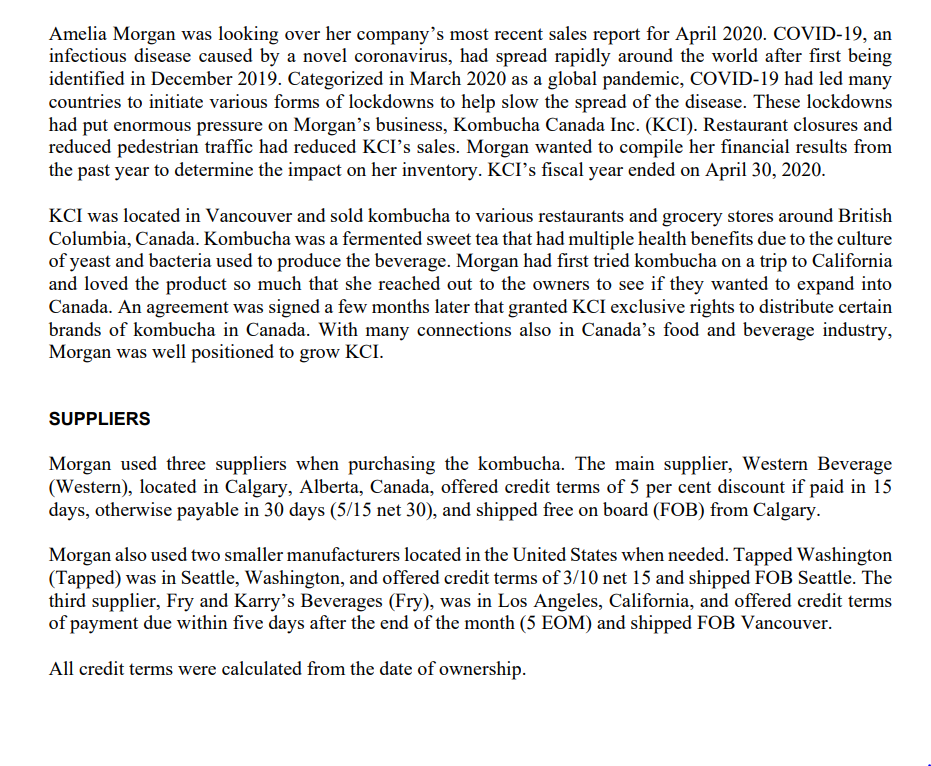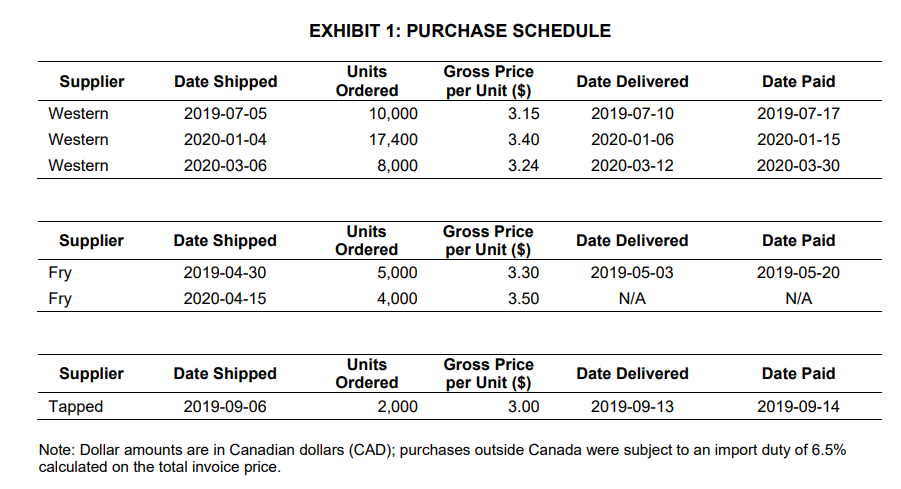Please answer the questions in the section: Next Steps.
NEXT STEPS To proceed with assessing the effect of the pandemic lockdowns on her inventory, Morgan needed to do the following:
1) Post all opening balances and inventory-related transactions in the ledger accounts (T-accounts) for fiscal 2020.
2) Calculate the total cost of each purchase to the nearest dollar and the cost per bottle of kombucha of each purchase to three decimals.
3) Determine the cost of goods available for sale, the ending inventory, and the cost of goods sold for the kombucha inventory using the first-in, first-out (FIFO) inventory valuation method.
4) Morgan knew that COVID-19 would have an impact on the future selling price of her kombucha. At the end of fiscal 2020, the net realizable value of Morgans kombucha was $3.20. She wondered what effect this net realizable value would have on her inventory valuation.
The data to the problem is below.


Amelia Morgan was looking over her company's most recent sales report for April 2020. COVID-19, an infectious disease caused by a novel coronavirus, had spread rapidly around the world after first being identified in December 2019. Categorized in March 2020 as a global pandemic, COVID-19 had led many countries to initiate various forms of lockdowns to help slow the spread of the disease. These lockdowns had put enormous pressure on Morgan's business, Kombucha Canada Inc. (KCI). Restaurant closures and reduced pedestrian traffic had reduced KCI's sales. Morgan wanted to compile her financial results from the past year to determine the impact on her inventory. KCI's fiscal year ended on April 30, 2020. KCI was located in Vancouver and sold kombucha to various restaurants and grocery stores around British Columbia, Canada. Kombucha was a fermented sweet tea that had multiple health benefits due to the culture of yeast and bacteria used to produce the beverage. Morgan had first tried kombucha on a trip to California and loved the product so much that she reached out to the owners to see if they wanted to expand into Canada. An agreement was signed a few months later that granted KCI exclusive rights to distribute certain brands of kombucha in Canada. With many connections also in Canada's food and beverage industry, Morgan was well positioned to grow KCI. SUPPLIERS Morgan used three suppliers when purchasing the kombucha. The main supplier, Western Beverage (Western), located in Calgary, Alberta, Canada, offered credit terms of 5 per cent discount if paid in 15 days, otherwise payable in 30 days (5/15 net 30), and shipped free on board (FOB) from Calgary. Morgan also used two smaller manufacturers located in the United States when needed. Tapped Washington (Tapped) was in Seattle, Washington, and offered credit terms of 3/10 net 15 and shipped FOB Seattle. The third supplier, Fry and Karry's Beverages (Fry), was in Los Angeles, California, and offered credit terms of payment due within five days after the end of the month (5 EOM) and shipped FOB Vancouver. All credit terms were calculated from the date of ownership. Kombucha needed to be delivered in a refrigerated truck, which increased the cost of shipping. KCI used a private shipping company when ordering from their supplier in Canada. Transportation charges were based on a per unit price of CA $0.361 A second shipping company was used for all orders from suppliers in the United States. Morgan knew the owner of this shipping company from a previous business relationship, and he offered her a set transportation charge that converted to an average of CA$800 per order. INVENTORY Morgan made several purchases throughout fiscal 2020 (see Exhibit 1). On September 13, 2019, Morgan noticed a quality issue with some of the units from the September 6, 2019, order from Tapped and promptly returned 150 bottles of kombucha. Tapped offered to pay for return shipping and to refund any applicable duties. Morgan also had to return 200 bottles from the January 4, 2020, order from Western because of damaged packaging. Western covered the return shipping charges. A physical inventory count on April 30, 2020, revealed 9,237 bottles of kombucha on hand. Morgan remembered she started the year with 2,422 bottles of kombucha worth $8,264. NEXT STEPS To proceed with assessing the effect of the pandemic lockdowns on her inventory, Morgan needed to do the following: - Post all opening balances and inventory-related transactions in the ledger accounts (T-accounts) for fiscal 2020. - Calculate the total cost of each purchase to the nearest dollar and the cost per bottle of kombucha of each purchase to three decimals. - Determine the cost of goods available for sale, the ending inventory, and the cost of goods sold for the kombucha inventory using the first-in, first-out (FIFO) inventory valuation method. Morgan knew that COVID-19 would have an impact on the future selling price of her kombucha. At the end of fiscal 2020, the net realizable value of Morgan's kombucha was $3.20. She wondered what effect this net realizable value would have on her inventory valuation. EXHIBIT 1: PURCHASE SCHEDULE Note: Dollar amounts are in Canadian dollars (CAD); purchases outside Canada were subject to an import duty of 6.5% calculated on the total invoice price. Amelia Morgan was looking over her company's most recent sales report for April 2020. COVID-19, an infectious disease caused by a novel coronavirus, had spread rapidly around the world after first being identified in December 2019. Categorized in March 2020 as a global pandemic, COVID-19 had led many countries to initiate various forms of lockdowns to help slow the spread of the disease. These lockdowns had put enormous pressure on Morgan's business, Kombucha Canada Inc. (KCI). Restaurant closures and reduced pedestrian traffic had reduced KCI's sales. Morgan wanted to compile her financial results from the past year to determine the impact on her inventory. KCI's fiscal year ended on April 30, 2020. KCI was located in Vancouver and sold kombucha to various restaurants and grocery stores around British Columbia, Canada. Kombucha was a fermented sweet tea that had multiple health benefits due to the culture of yeast and bacteria used to produce the beverage. Morgan had first tried kombucha on a trip to California and loved the product so much that she reached out to the owners to see if they wanted to expand into Canada. An agreement was signed a few months later that granted KCI exclusive rights to distribute certain brands of kombucha in Canada. With many connections also in Canada's food and beverage industry, Morgan was well positioned to grow KCI. SUPPLIERS Morgan used three suppliers when purchasing the kombucha. The main supplier, Western Beverage (Western), located in Calgary, Alberta, Canada, offered credit terms of 5 per cent discount if paid in 15 days, otherwise payable in 30 days (5/15 net 30), and shipped free on board (FOB) from Calgary. Morgan also used two smaller manufacturers located in the United States when needed. Tapped Washington (Tapped) was in Seattle, Washington, and offered credit terms of 3/10 net 15 and shipped FOB Seattle. The third supplier, Fry and Karry's Beverages (Fry), was in Los Angeles, California, and offered credit terms of payment due within five days after the end of the month (5 EOM) and shipped FOB Vancouver. All credit terms were calculated from the date of ownership. Kombucha needed to be delivered in a refrigerated truck, which increased the cost of shipping. KCI used a private shipping company when ordering from their supplier in Canada. Transportation charges were based on a per unit price of CA $0.361 A second shipping company was used for all orders from suppliers in the United States. Morgan knew the owner of this shipping company from a previous business relationship, and he offered her a set transportation charge that converted to an average of CA$800 per order. INVENTORY Morgan made several purchases throughout fiscal 2020 (see Exhibit 1). On September 13, 2019, Morgan noticed a quality issue with some of the units from the September 6, 2019, order from Tapped and promptly returned 150 bottles of kombucha. Tapped offered to pay for return shipping and to refund any applicable duties. Morgan also had to return 200 bottles from the January 4, 2020, order from Western because of damaged packaging. Western covered the return shipping charges. A physical inventory count on April 30, 2020, revealed 9,237 bottles of kombucha on hand. Morgan remembered she started the year with 2,422 bottles of kombucha worth $8,264. NEXT STEPS To proceed with assessing the effect of the pandemic lockdowns on her inventory, Morgan needed to do the following: - Post all opening balances and inventory-related transactions in the ledger accounts (T-accounts) for fiscal 2020. - Calculate the total cost of each purchase to the nearest dollar and the cost per bottle of kombucha of each purchase to three decimals. - Determine the cost of goods available for sale, the ending inventory, and the cost of goods sold for the kombucha inventory using the first-in, first-out (FIFO) inventory valuation method. Morgan knew that COVID-19 would have an impact on the future selling price of her kombucha. At the end of fiscal 2020, the net realizable value of Morgan's kombucha was $3.20. She wondered what effect this net realizable value would have on her inventory valuation. EXHIBIT 1: PURCHASE SCHEDULE Note: Dollar amounts are in Canadian dollars (CAD); purchases outside Canada were subject to an import duty of 6.5% calculated on the total invoice price









